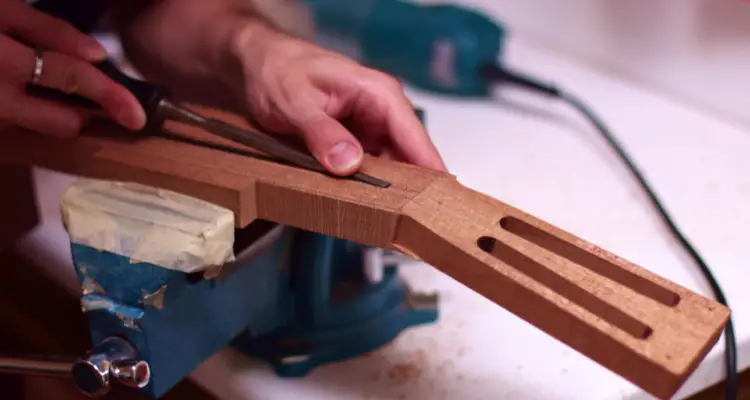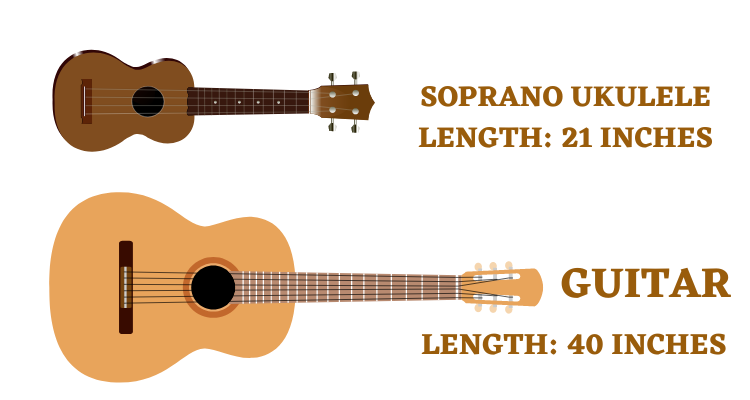Truss rods are an important part of guitar and other stringed instruments. This prevents the neck from bending due to the force applied by the strings on the neck.
So, oftentimes ukulele enthusiasts ask me,
Contents
Do Ukuleles Have truss Rods?
Here is the short answer: Actually, most ukuleles don’t have truss rods? Ukulele has plastic strings and a short neck which actually doesn’t need truss rods. The plastic strings don’t apply as much pressure that requires truss rod. However, in a few models of Baritone ukulele (have longer neck) you will find truss rods. But small models such as Soprano and COncert ukuleles don’t have truss rods.
In this article, I’ll discuss with you in detail, why ukuleles don’t have truss rods.
What are Truss Rods?

Truss rods are support rods used to prevent the bending of the neck of any stringed instruments.
It runs through the middle of the neck. They are usually built of steel because of the high elasticity of this metal. However, in some high-end guitars and other instruments, manufacturers may also use carbon fiber.
So, truss rod is an essential part of a string instrument like guitar, bass guitar, etc.
Disclosure: This post may contain affiliate links, which means we may receive a commission if you click a link and purchase something that we recommended. Read more about Affiliate disclosure here.
You can easily access the truss rods from different locations such as Inside the sound hole of the instrument, the base of the neck, and the neck head.
Why are Truss Rods Used?

The main purpose of a truss rod is to prevent the bending of the neck due to the heavy tension applied by the steel strings.
Temperature change and humidity also affect steel strings and the wooden neck which causes bending or swelling.
Truss rod also prevents the instrument from deformation due to temperature changes and humidity.
Truss rods are introduced by Thaddeus McHugh, an employee of the Gibson company in 1921. He first applied it on Gibson guitars and later he got a patent for this.
With time other guitar companies adopted this for their products and it got popular.
But, truss rods are generally not used in ukuleles. I admit exceptions are always there but most of the ukuleles don’t have truss rods.
Do, you know why?
Here’s the answer…
Why Most Ukuleles Don’t Have Truss Rods?
There are a few reasons why ukuleles don’t have truss rods. Let me explain them one by one.
Ukuleles are smaller

Ukuleles are smaller in size compared to guitars. A Soprano ukulele is only 21 inches long and putting a truss rod in this size instrument is really challenging.
It needs extra labor to install truss rods in these tiny instruments that’s one of the reasons why truss rods are not used in ukuleles, especially the cheaper ones.
Considering Weight
Ukulele is an easy-to-carry instrument that anyone can hold on to even without the strap.
It is easily portable due to its lightweight. And, it’s known for its lightweight.
Manufacturers, don’t want to make it heavy by adding a steel truss rod to it.
Nylon Strings are Used in Ukuleles

Nylon string which is used in most ukuleles is a low-elastic material. It doesn’t apply more tension on the neck like steel string.
So, actually, there is no need to install a truss rod to prevent form neck bending due to strings.
However, temperature and humidity are not considered here.
Due to The History of Ukulele
According to Wikipedia, Madeiran cabinet makers Manuel Nunes, José do Espírito Santo, and Augusto Dias introduced the first ukulele in August 1879.
Guitar was not as popular as ukulele in the 18th to 20th centuries.
And, people were familiar with the lightweight of the ukulele. In the modern era, this trend is going on, and hence ukulele manufacturers don’t want to make it heavy by adding a truss rod to it.
Do Ukuleles Need Truss Rods?
Soprano and concert-size ukuleles don’t need truss rods. There’s not much tension in the nylon strings used in them. Also, their smaller size neck is able to handle this pressure.
That’s why we don’t need a truss rod on them.
However, if we use steel strings, a truss rod will be essential. Steel strings apply way more tension which causes the bending of the neck, that’s where you need a truss rod.
Also, longer-size ukuleles (Tenor and Baritone) need truss rods. The long neck used in them is ten to bend due to tension. Here we need a truss rod to protect the neck.
Which Type of Ukulele Has Truss Rods?
Generally, Soprano and Concert ukuleles don’t need truss rods. But, longer-size ukuleles such as Baritone, U-Bass models need truss rods.
Such as Baritone and tenor ukuleles which are respectively 29 inches and 26 inches long need truss rods.
Also, a guitelele in which steel strings are used needs truss rods.
Here is the full list of ukuleles that have truss rods.
- Baritone
- Guitalele
- Tenor
- U-bass
Adjusting the Truss Rod in Ukulele
Here is the step-by-step guide to adjusting the truss rod of the ukulele.
First off,
Note: Not all ukuleles have truss rods, so make sure your ukulele has truss rod before proceeding with this step-by-step guide.
Check if your ukulele needs truss rod adjustment
- The neck of the ukulele is bowed or warped.
- Strings seem too high or too low above the fretboard.
- Frequent out of tune
If these are happening, you need truss rod adjustment.
Now, let’s discuss how to do it.
Tools required
- A ukulele tuner
- A head screwdriver or Allen key as per need
- A capo
Adjustment Guide
- Lose the strings: Before adjusting the truss rod, you need to loosen the strings. This helps to relieve tension from the neck.
- Locate the truss rod adjustment point: You have to locate the truss rod adjustment point which can be found at the base of the neck, either at the headstock or the soundhole.
- Adjust the truss rod: Insert the appropriate head screwdriver or Allen Key as per required into the truss rod adjustment point and turn it clockwise to tighten the truss rod or counterclockwise to loosen the truss rod. Turn only small increments and retest the results after each adjustment.
- Measure the string height: After one increment measure the string height (or action) at the 12th fret. The recommended string height for a ukulele is around 2-2.5mm.
- Re-tune the ukulele: After adjusting the truss rod and measuring the string height, you have to re-tune the ukulele using a tuner.
- Test by playing: Play the ukulele now and check if you are able to press the strings easily on the fretboard. If the action is too high or too low, you may need to repeat the process.
Conclusion
So, here you’ve read all about the ukulele truss rods and why truss rods are not used in most ukuleles.
However, some ukulele types have truss rods but they are not much popular as Soprano or Concert. So, we can conclude that most ukuleles don’t have truss rods.
Now. let me know in the comments if you have any queries about truss rods. I will answer all your queries.
Happy ukulele playing…
Related posts,
